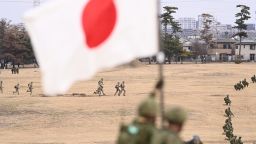Japan Equips Warship with Tomahawk Missiles Amid Regional Tensions

Japan is enhancing its military capabilities by equipping the JS Chokai, a guided-missile destroyer, with Tomahawk cruise missiles. This decision comes as the Pacific arms race escalates, driven by increasing military activities from regional adversaries such as China and North Korea. The Chokai is currently en route to the United States for modifications that will enable it to launch these advanced missiles, which have a striking range of approximately 1,000 miles.
During a year-long deployment, the JS Chokai will undergo extensive modifications and crew training. The acquisition of 400 Tomahawk missiles was formalized in a deal between Japan and the United States in early 2024. Japan’s Defense Minister, Gen Nakatani, referred to the current security landscape as the “most severe and complex” since World War II. A report released by the Japanese Defense Ministry emphasizes that China’s military expansion poses the “greatest strategic challenge” to Japan, particularly concerning activities in the contested Senkaku Islands.
The escalating military capabilities of Beijing were on full display during a military parade in Beijing on September 3, where advanced anti-ship missiles were showcased. Notably, Chinese leader Xi Jinping was joined by North Korean leader Kim Jong Un and Russian President Vladimir Putin, the latter having recently signed a defense treaty with North Korea.
In its announcement regarding the Chokai’s deployment, the Japanese Defense Ministry stated that the Self-Defense Forces are enhancing their stand-off defense capabilities to counter potential threats swiftly and effectively. While Japan describes the Tomahawk missiles as enhancing its defensive posture, these weapons are recognized globally as offensive systems. The U.S. Navy classifies them as “used for deep land-attack warfare,” with the full designation being the Tomahawk Land Attack Missile or TLAM.
Beijing has reacted strongly to Japan’s acquisition of Tomahawks, asserting that it violates Japan’s post-World War II pacifist principles, which limit the Self-Defense Forces to defensive roles. Chinese Foreign Ministry spokesperson Mao Ning stated that the moves by the U.S. and Japan contribute to an arms race, undermining regional stability and the global strategic balance.
The Tomahawk missiles are among the most reliable in the U.S. arsenal, with manufacturer Raytheon asserting that they can strike targets with precision from up to 1,000 miles away, even in well-defended airspace. The missiles have seen extensive use, with over 2,000 combat deployments, including recent strikes on Iranian nuclear facilities.
The Japanese Defense Ministry aims to have the JS Chokai operational for “actual missions” by next summer, a timeline that includes live-fire testing. Initial preparations have begun, with the Chokai conducting drills to load dummy Tomahawk munitions into its vertical launch system. Weighing 9,500 tons and measuring 528 feet in length, the Chokai is equipped with 90 vertical launch cells, capable of launching various missile types, including surface-to-air and anti-submarine rockets.
The development of Tomahawk capabilities is not isolated to Japan. The Royal Australian Navy and Britain’s Royal Navy have also demonstrated the ability to launch these missiles. Australia successfully fired a Tomahawk from the destroyer HMAS Brisbane off the U.S. West Coast in December 2023, with plans to acquire 200 Tomahawks to enhance its long-range strike capabilities against land targets.
As Japan fortifies its military capacity in response to regional threats, the implications of this arms expansion may significantly shape the security dynamics in the Asia-Pacific region. The ongoing developments reflect a broader trend of military modernization among U.S. allies in the face of evolving threats from adversaries like China and North Korea.






